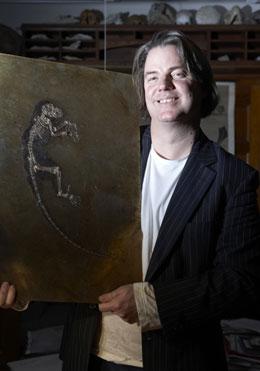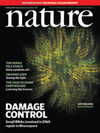 Jørn Hurum has accompanied the fossilized primate he nicknamed Ida on a world tour to fame and notoriety in the last week. The 47-million-year-old fossil is famous for its haunting completeness — the outlines of its fur and its last meal appear like a shadow around the intact skeleton. Yet Hurum has drawn fire for promoting the fossil and its potential links to human ancestors through a multi-platform media campaign alongside the release of a scientific paper that describes the fossil’s genealogy more modestly. Today, he and Ida paused in London to discuss the fallout of the publicity and the next scientific steps. Continue reading Taking a fossil primate on the road
Jørn Hurum has accompanied the fossilized primate he nicknamed Ida on a world tour to fame and notoriety in the last week. The 47-million-year-old fossil is famous for its haunting completeness — the outlines of its fur and its last meal appear like a shadow around the intact skeleton. Yet Hurum has drawn fire for promoting the fossil and its potential links to human ancestors through a multi-platform media campaign alongside the release of a scientific paper that describes the fossil’s genealogy more modestly. Today, he and Ida paused in London to discuss the fallout of the publicity and the next scientific steps. Continue reading Taking a fossil primate on the road
Tag Archives: Nature internship
Nature Internship 6: Ida
 This week my work, like much of the science media world, was dominated by a 47-million-year-old fossilized primate nicknamed Ida. It is an exciting find, primarily because of its completeness, and it’s gotten a lot of attention. I wrote a pair of blog posts on Monday and Wednesday sandwiching the actual news story I wrote on Tuesday. If you only read one, I’d recommend the Wednesday blog post.
This week my work, like much of the science media world, was dominated by a 47-million-year-old fossilized primate nicknamed Ida. It is an exciting find, primarily because of its completeness, and it’s gotten a lot of attention. I wrote a pair of blog posts on Monday and Wednesday sandwiching the actual news story I wrote on Tuesday. If you only read one, I’d recommend the Wednesday blog post.
I also wrote a news story about how neither the sky nor GPS as we know it are falling, but there’s a growing chance that the GPS signal many scientists rely on may drop in quality during the next few years. That story was a good learning experience: my editor and I spent a while negotiating the headline and first sentence, which I thought didn’t really represent the cautionary note I thought the rest of the story struck. But I’m learning to choose my battles and cooperate with colleagues, I hope.
Reunion of fossil halves splits scientists
 Palaeontologists have identified a new species of primate by putting together two halves of an unusually complete fossil, which were separated for decades by the vagaries of the fossil trade. One half of the fossil — which some media reports have been quick to label ‘the missing link’ — was even doctored by a past owner to make it look more impressive.
Palaeontologists have identified a new species of primate by putting together two halves of an unusually complete fossil, which were separated for decades by the vagaries of the fossil trade. One half of the fossil — which some media reports have been quick to label ‘the missing link’ — was even doctored by a past owner to make it look more impressive.
The relationship of the new species, Darwinius masillae, to other early primates has sparked an academic controversy, a press conference earlier today at the American Museum of Natural History and a television documentary to air next week. Continue reading Reunion of fossil halves splits scientists
Nature Internship 5: Back to the office
 Handle money often? It might help you tolerate pain, according to psychologists who found that volunteers who handled bills or even just thought about money were better at handling social rejection and physical pain than those who thought about neutral topics. I wrote a news story about the study this week. I also wrote about an astronomer who thinks he knows why hundreds of naked-eye observers have seen long-lasting flashes of light on the moon. Columbia grad student Cameron Hummels mentioned this research to me when I was profiling him for Science Careers this winter–it was fun to follow up on the tip and turn it into a story.
Handle money often? It might help you tolerate pain, according to psychologists who found that volunteers who handled bills or even just thought about money were better at handling social rejection and physical pain than those who thought about neutral topics. I wrote a news story about the study this week. I also wrote about an astronomer who thinks he knows why hundreds of naked-eye observers have seen long-lasting flashes of light on the moon. Columbia grad student Cameron Hummels mentioned this research to me when I was profiling him for Science Careers this winter–it was fun to follow up on the tip and turn it into a story.
Not long after my Alpine ski tour (sadly not part of my work for Nature), I attended a Microsoft Research demonstration day in Cambridge where I played with futuristic gadgets and spoke with researchers working in everything from computational biology to 3-d visualization hardware. I also finally met one of the engineers behind SenseCam, who was out of town when I reported on the device for Science in March.
And back at the office, I’ve blogged about some look-alike journals produced by Elsevier on behalf of drugmaker Merck (here and here), the FDA’s accusations that Cheerios has mislabeled its cereal, and a possible nomination to fill the empty NASA administrator role.
Update: My story about money and pain appeared in the Costa Rican newspaper La Nación [html] [pdf-like format] on 1 June.
